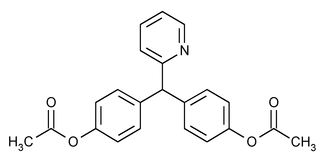Bisacodyl
(bis ak' oh dil).
Phenol, 4,4¢-(2-pyridinylmethylene)bis-, diacetate (ester).
4,4¢-(2-Pyridylmethylene)diphenol diacetate (ester)
» Bisacodyl contains not less than 98.0 percent and not more than 101.0 percent of C22H19NO4, calculated on the dried basis.
[Caution—Avoid inhalation and contact with the eyes, skin, and mucous membranes.
]
Packaging and storage—
Preserve in well-closed containers.
Identification—
A:
Infrared Absorption  197S
197S —
—
Cell:
1.0 mm.
Solution:
1 in 200 solution in chloroform, previously dried.
B:
Ultraviolet Absorption  197U
197U —
—
Solution:
20 µg per mL.
Medium:
0.05 N hydrochloric acid.
Absorptivities at 263 nm, calculated on the dried basis, do not differ by more than 3.0%.
Melting range  741
741 :
between 131
:
between 131 and 135
and 135 .
.
Loss on drying  731
731 —
Dry it at 105
—
Dry it at 105 for 2 hours: it loses not more than 0.5% of its weight.
for 2 hours: it loses not more than 0.5% of its weight.
Residue on ignition  281
281 :
not more than 0.1%.
:
not more than 0.1%.
Heavy metals, Method II  231
231 :
0.001%.
:
0.001%.
Assay—
Dissolve about 250 mg of Bisacodyl, accurately weighed, in 70 mL of glacial acetic acid, add 3 drops of p-naphtholbenzein TS, and titrate with 0.1 N perchloric acid VS. Perform a blank determination, and make any necessary correction. Each mL of 0.1 N perchloric acid is equivalent to 36.14 mg of C22H19NO4.
Auxiliary Information—
Please check for your question in the FAQs before contacting USP.
| Topic/Question | Contact | Expert Committee |
|---|---|---|
| Monograph | Elena Gonikberg, Ph.D.
Principal Scientific Liaison 1-301-816-8251 |
(SM32010) Monographs - Small Molecules 3 |
| Reference Standards | RS Technical Services 1-301-816-8129 rstech@usp.org |
USP35–NF30 Page 2364
Pharmacopeial Forum: Volume No. 37(3)

